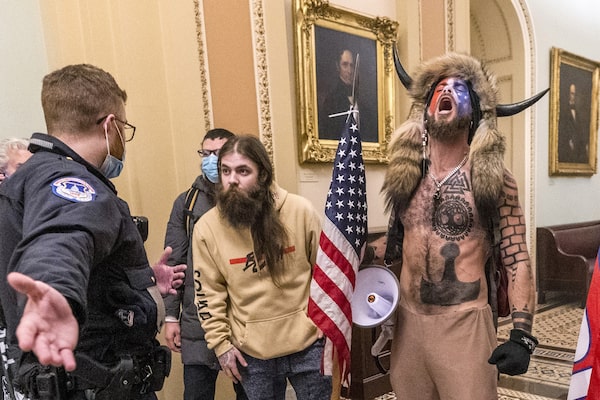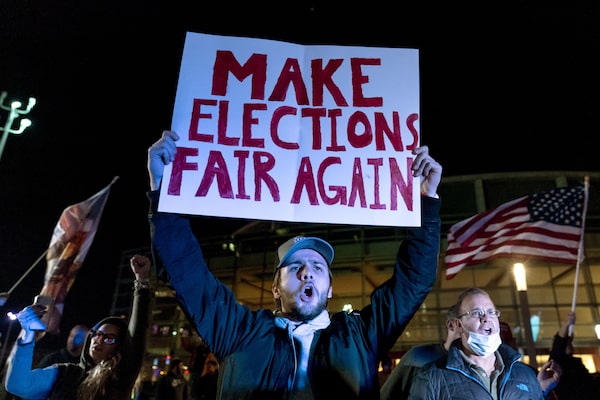
Trump supporters climb the west wall of the U.S. Capitol this past Jan. 6 after a mob stormed the legislature, where Congress was formally counting the votes making Joe Biden the next U.S. president.Jose Luis Magana/The Associated Press
David Shribman is the former executive editor of the Pittsburgh Post-Gazette and winner of the Pulitzer Prize for coverage of U.S. politics. He teaches at McGill University’s Max Bell School of Public Policy.
We know that Donald Trump did not accept that he lost the 2020 election. We know that the White House was the apparent base camp of a conspiracy to overturn the election results. We know that on Jan. 6 the 45th U.S. president gave an incendiary speech that roused his supporters. We know that a mob, determined to prevent the Electoral College vote-counting formality that would deliver the election to Joe Biden, besieged the Capitol, breaching its security barriers, ransacking the symbolic centre of American democracy, trampling the blue-and-garnet inlaid floor tiles that were installed when the first strains of the Civil War were breaking the country apart.
But broader questions surrounding Jan. 6 – the ones that will be the province of historians, rather than the continuing concerns of law enforcement and the courts – remain in a country that once was farsighted but now looks at the world through bifocals. A year later, there are things we still can’t quite know.

U.S. Capitol police confront insurrectionists outside the Senate chamber.Manuel Balce Ceneta/The Associated Press
Was the Jan. 6 insurrection a one-off or a precursor to something bigger?
If the Capitol siege was a one-time event, it will be regarded as a stain on the country’s history, the political equivalent of Puccini’s brief overture in Tosca.
If, instead, it is a warning of rebellions to come, it will be remembered as a 21st-century update of Thomas Jefferson’s description of Missouri’s 1819 application to join the Union as a slave state: as a “firebell in the night.”
“This is the big question, one we should confront regardless of the final answer,” said Pauline Moore, a RAND Corporation expert on terrorism and insurgency. “This may have been a disorganized event – not co-ordinated or funded in a meaningful way – but that isn’t saying we won’t see copycat, better-organized events to continue that fight.”
Shacks erected by the Bonus Army, a protest group made up mostly of veterans, burn on Washington's Anacostia flats in 1932.
Have there been other domestic uprisings that are even remotely comparable to the siege at the Capitol?
American history began with a rebellion. There were anti-draft riots in New York during the Civil War; a 1932 armed confrontation at the Capitol between First World War veterans demanding early payment of service bonuses and military forces led by General Douglas MacArthur; and a bombing in the Capitol perpetrated by the Weather Underground militant group in 1971.
“There are lots of ugly and awful riots in American history and there have been terrorist acts, but Jan. 6 was of a different order,” said Michael Kazin, a Georgetown University historian and biographer of William Jennings Bryan, the great Populist Party leader. “We will debate forever whether Trump egged it on or just smiled and let it happen, but it was an attack on one of the basic procedures of our democracy.”
How did the movement behind Jan. 6 differ from the forces that created other populist protest movements?
Many of the early populist insurrections were agrarian in nature. In both Iowa and Wisconsin, farmers incited violent “Oleo Wars” to prevent labels from suggesting oleomargarine was a dairy product. Farmers opposed to requirements that cattle be tested for bovine tuberculosis produced a Depression-era “Cow War” that saw protesters blocking 10 routes to Sioux City, Iowa, and emptying their milk cans into the streets. “It was open rebellion here,” George Mills, who covered the issue for the Marshalltown Times Republican, told me before he died in 2003.
“Most of those populist movements weren’t directed by a cult of personality,” said Sarah Purcell, a historian at Grinnell College in Iowa. “People were rallying around issues, not a person. And they were much more grassroots movements. The Trump movement has grassroots support but is financed by billionaires and political action committees and supported by one of the major political parties.”
National Guard members sleep at the Capitol this past Jan. 13 when Democrats began debate on an article of impeachment against Donald Trump.Joshua Roberts/Reuters
Is the greatest threat to America now domestic, not foreign? And how often has that happened?
Aside from the attack on Pearl Harbor, the decades-long struggles of the Cold War and the Sept. 11, 2001, terrorist attacks, there have been very few military threats to a country that has been protected from European and Asian conflict by ocean moats. The threat that led to U.S. involvement in the First World War was more commercial than military; Woodrow Wilson took the country into war over the freedom of the seas, which had also prompted the U.S. declaration of the War of 1812.
Overall, the gravest threats to the country have been homegrown, emerging from the Civil War, the late years of postwar Reconstruction (with the establishment of segregation, known as the Jim Crow laws, representing a serious backsliding of democratic rule) and domestic unrest that, while being far less dangerous, grew out of the civil-rights and Vietnam protests, as well as the high-profile assassinations of the 1960s.
“The threat today doesn’t come from foreign nations but from erosion of belief in constitutional and legal processes, facts and objective reality,” said Christopher Gelpi, the director of Ohio State University’s Center for International Security Studies. “All are essential to the operation of democracy. We historically have acknowledged the winner in elections, and without that we don’t really have a country.’’

A Trump supporter chants outside a vote-counting facility in Detroit on Nov. 5, 2020.David Goldman/The Associated Press
Are the varying perceptions of Jan. 6 a measure of the growing polarization in U.S. politics?
Americans have been at loggerheads with each other throughout their history. These schisms have been along generational (the rebellions of the 1960s) and geographical lines (opposition to the War of 1812 and to the 1846-1848 Mexican War largely in the Northeast, for example, or the dispute over slavery that split North from South).
But while those conflicts split families, the current strife sets the educated against the less educated and the urban against the rural, creating a genuine feud of cultures and outlooks.
“It would be much harder to mount a moderate movement today than it was for us in 1985,” said Alvin From, who that year founded the Democratic Leadership Council and enlisted such mainstream figures as governor Bill Clinton of Arkansas. “The yawning gap between how the Capitol siege is seen underlines the growing gap in American life.”
A member of the Proud Boys extremist group attends an anti-Biden rally in Ortonville, Mich., on Nov. 20.Emily Elconin/Reuters
Are right-wing militia movements and left-wing progressive movements both strains of discontent with contemporary American culture?
The dangerous element of this era is that both the left and the right strongly disapprove of the direction America is taking – a phenomenon that Mr. Trump and his polar opposite, Senator Bernie Sanders of Vermont, both identified in 2016. ”Donald Trump tapped into the anger of a declining middle class that is sick and tired of establishment economics, establishment politics and the establishment media,” Mr. Sanders said a day after Mr. Trump defeated Hillary Clinton.
“Trump ran on a populist platform saying that people are being screwed by the educated and the wealthy and those living in Los Angeles and New York – a sense there are extremely powerful forces that have increasing power over how society functions,” said Lester Spence, a Johns Hopkins University political scientist. “At the same time on the left there is a sense that wealth inequality is growing.”
And yet there is a difference. “The Jan. 6 uprising,” Dr. Spence argued, “was an attempt to overthrow the government that was generated by a former president.’’
So in a way, people on the right and the left, and increasingly people in the middle, agree – but only to disagree on the fundamentals of the American project.
America in 2022: More from The Globe and Mail

The Globe and Mail
Stephen Marche: 2022 is the year America falls off a cliff. How will Canada hang on?
Thomas Homer-Dixon: The American polity is cracked, and might collapse. Canada must prepare
Michael Adams: We’re witnessing the continuing cultural divergence of Canada and the United States
Konrad Yakabuski: Democracy in America is stronger than it looks
Editorial: Joe Biden’s presidency is in big trouble – and that’s good news for Donald Trump
 David Shribman
David Shribman